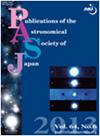Solar horizontal flow evaluation using neural network and numerical simulations with snapshot data
IF 2.2
4区 物理与天体物理
Q2 ASTRONOMY & ASTROPHYSICS
引用次数: 0
Abstract
Abstract We suggest a method that evaluates the horizontal velocity in the solar photosphere with easily observable values using a combination of neural network and radiative magnetohydrodynamics simulations. All three-component velocities of thermal convection on the solar surface have important roles in generating waves in the upper atmosphere. However, the velocity perpendicular to the line of sight (LoS) is difficult to observe. To deal with this problem, the local correlation tracking (LCT) method, which employs the difference between two images, has been widely used, but this method has several disadvantages. We develop a method that evaluates the horizontal velocity from a snapshot of the intensity and the LoS velocity with a neural network. We use data from numerical simulations for training the neural network. While two consecutive intensity images are required for LCT, our network needs just one intensity image at only a specific moment for input. From these input arrays, our network outputs a same-size array of a two-component velocity field. With only the intensity data, the network achieves a high correlation coefficient between the simulated and evaluated velocities of 0.83. In addition, the network performance can be improved when we add LoS velocity for input, enabling us to achieve a correlation coefficient of 0.90. Our method is also applied to observed data.基于神经网络和快照数据的数值模拟的太阳水平流评价
摘要:本文提出了一种利用神经网络和辐射磁流体力学模拟相结合的方法,以易于观测的数值来评估太阳光球中的水平速度。太阳表面热对流的所有三分量速度在高层大气中产生波具有重要作用。然而,垂直于视线的速度很难观测到。为了解决这一问题,局部相关跟踪(LCT)方法得到了广泛的应用,该方法利用了两幅图像之间的差异,但该方法存在一些缺点。我们开发了一种利用神经网络从强度和LoS速度的快照中评估水平速度的方法。我们使用数值模拟的数据来训练神经网络。虽然LCT需要两个连续的强度图像,但我们的网络只需要在特定时刻输入一个强度图像。从这些输入数组中,我们的网络输出一个相同大小的双分量速度场数组。仅使用强度数据,网络模拟速度与评估速度之间的相关系数较高,为0.83。此外,当我们加入LoS速度作为输入时,可以提高网络性能,使我们的相关系数达到0.90。我们的方法也适用于观测数据。
本文章由计算机程序翻译,如有差异,请以英文原文为准。
求助全文
约1分钟内获得全文
求助全文
来源期刊

Publications of the Astronomical Society of Japan
地学天文-天文与天体物理
CiteScore
4.10
自引率
13.00%
发文量
98
审稿时长
4-8 weeks
期刊介绍:
Publications of the Astronomical Society of Japan (PASJ) publishes the results of original research in all aspects of astronomy, astrophysics, and fields closely related to them.
 求助内容:
求助内容: 应助结果提醒方式:
应助结果提醒方式:


